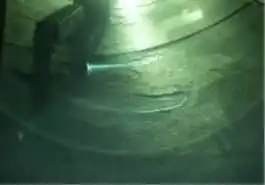Crude Desalters
We Stop Aggressive Pitting Corrosion in the Liquid Phase of Crude Oil Desalters With an Onsite Internal CRA Cladding
A desalter is a critical refinery process asset. It is typically a large horizontal vessel, the second part of a two-stage desalting process to clean the feed.
Crude desalters perform an important role in the initial oil separation and cleaning process by removing salts that can cause significant corrosion damage to downstream processing equipment if left in the process fluid.
The water and oil mixture is piped into the desalter vessel through an inlet distributor system in order to pass the fluid through an electrostatic field. We stop pitting corrosion of crude oil desalters on-site.

Pitting Corrosion of Desalter Vessel Shell
The process conditions in a desalter contribute to vessel shell corrosion with the generation of hydrochloric acid by the hydrolysis of the chloride salts present in the incoming crude oil, in particular magnesium chloride and calcium chloride. The presence of H2S can also lead to risks of cracking. Localized failure of existing corrosion barriers (e.g. the metal passive layer or organic coating systems) due to this aggressive media or cleaning processes means that desalters often suffer from accelerated localized pitting corrosion in the bottom 1/3rd of the vessel (the liquid phase). The pitting corrosion will typically be undetected until an internal inspection (every 3 to 4 years) or loss of containment occurs (in severe cases). Vessel repair and mechanical restoration require weld build up and post-weld heat treatment. In many cases, the repairs carry a high risk of vessel distortion or damage.
On-Site Thermal Spray Cladding
The IGS HVTS® (High Velocity Thermal Spray) high nobility CRA cladding system works as a highly effective corrosion barrier that prevents the process aggressive media from contacting the vessel base metal, thereby preventing corrosion and metal wastage in this critical process vessel. The HVTS® cladding is practically impermeable and inert to the environment. Its long-term performance, resistance to steam out, robust nature, and capability to externally inspect, enables refinery personnel to monitor performance and asset integrity without entering the vessel. With RBI inspection techniques, this allows facilities to extend the time between shutdowns, increasing asset availability, and reducing downtime and OPEX.
Due to their size, desalter vessels often form part of the critical path for client outages and shutdowns. Where repeat failure of existing mitigation systems occurs (e.g. organic coatings) the required extensive repairs often lead to an extension of the turnaround and significant opportunity cost to the plant.

On-Site Cladding for Crude Processing Equipment
IGS has decades of experience executing challenging applications on critical process equipment such as desalters in the O&G industry, with references and case histories available.
Our ability to protect a desalter vessel shell and minimize production losses are a key driver for O&G facilities to adopt the technology. The use of the IGS 5XXX HVTS® cladding process is often deemed more economical when compared to weld metal overlay due to shut down critical path time sensitivity.
One case history showed that the cost of a weld metal overlay solution would have been approximately $12MM more than the cost of the IGS 5xxx HVTS® application, thus saving the plant a considerable amount of money on the corrosion barrier installation. In another case cost savings of approximately $10MM are realized over a four-year period versus an organic coating solution due to reduced outage time related to repairs, inspection, and turnaround time savings of repeated re-application/repair of the previous fragile organic system. This calculation is derived from the expected duration of the repair/replacement of the organic coating at the inspection intervals and further maintenance due to recurring corrosion. As similar scope was performed on three other vessels in the turnaround, the use of the IGS HVTS® corrosion barrier maintenance approach shaved three days off the critical path schedule with an overall saving of $75MM.

I’m here to help
Colin Bateman
IGS Subject Matter Expert
Free consultation with an IGS Subject Matter Expert
IGS is here to provide information, answer questions and create an effective solution for your needs.
